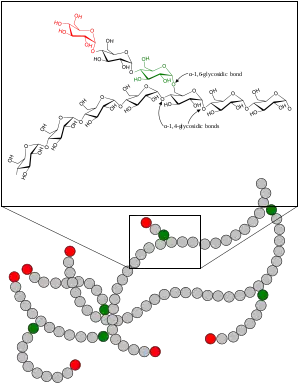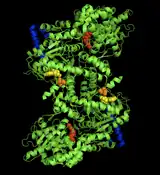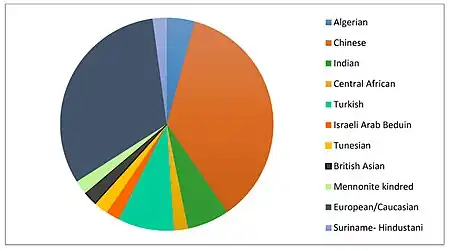Glycogen storage disease type VI
| Glycogen storage disease type VI | |
|---|---|
| Other names: Glycogen storage disease due to liver glycogen phosphorylase deficiency[1] | |
 | |
| Glycogen | |
Glycogen storage disease type VI (GSD VI) is a type of glycogen storage disease caused by a deficiency in liver glycogen phosphorylase or other components of the associated phosphorylase cascade system.[2] It is also known as "Hers' disease", after Henri G. Hers, who characterized it in 1959.[3] The scope of GSD VI now also includes glycogen storage disease type VIII,[2] IX[2] (caused by phosphorylase b kinase deficiency) and X[2] (deficiency protein kinase A).
The incidence of GSD VI is approximately 1 case per 65,000–85,000 births,[2] representing approximately 30% all cases of glycogen storage disease.
Signs and symptoms
Patients generally have a benign course, and typically present with hepatomegaly and growth retardation early in childhood. Mild hypoglycemia, hyperlipidemia, and hyperketosis may occur. Lactic acid and uric acid levels may be normal. However, lactic acidosis may occur during fasting.[4]
Cause

In terms of the etiology we find that mutations in the PYGL gene cause this disease. The gene gives instructions for creating liver glycogen phosphorylase, which is found in liver cells[5]
Diagnosis
The diagnosis of Glycogen storage disease type VI is based on the following:[6]
- Clinical findings
- Molecular genetic test
- Liver biopsy
Treatment
Because symptoms of GSD6 are generally mild, the disorder usually requires no treatment other than to avoid prolonged periods without eating. Because glycogen is only broken down when stored energy needs to be used, eating frequent meals can prevent the need to break down glycogen. Levels of blood glucose should be monitored to make sure that the diet is working correctly. This will minimize the symptoms of the disease.
Epidemiology

In terms of distribution of this disease we find via a 2021 review, that 39.1% of those affected were Caucasian/European origin, 36.2% were Chinese, 8.5% were Turkish, 6.4% were Indian and the other numbers fell below 5%, per Grünert, et al.[7]
See also
- Phosphorylase kinase
References
- ↑ RESERVED, INSERM US14-- ALL RIGHTS. "Orphanet: Glycogen storage disease due to liver glycogen phosphorylase deficiency". www.orpha.net. Archived from the original on 1 April 2020. Retrieved 11 April 2019.
- 1 2 3 4 5 Glycogen-Storage Disease Type VI at eMedicine
- ↑ Hers HG (1959). "[Enzymatic studies of hepatic fragments; application to the classification of glycogenoses.]". Rev Int Hepatol (in français). 9 (1): 35–55. PMID 13646331.
- ↑ "Glycogen storage disease type VI". Archived from the original on 2020-08-09. Retrieved 2021-01-27.
- ↑ "Glycogen storage disease type VI: MedlinePlus Genetics". medlineplus.gov. Archived from the original on 2023-04-24. Retrieved 2023-10-27.
- ↑ Labrador, Emma; Weinstein, David A. (1993). "Glycogen Storage Disease Type VI". GeneReviews®. University of Washington, Seattle. Archived from the original on 2023-02-03. Retrieved 2023-10-26.
- 1 2 Grünert, Sarah Catharina; Hannibal, Luciana; Spiekerkoetter, Ute (3 August 2021). "The Phenotypic and Genetic Spectrum of Glycogen Storage Disease Type VI". Genes. 12 (8): 1205. doi:10.3390/genes12081205. ISSN 2073-4425.
Further reading
- GeneReview/NIH/UW entry on Glycogen Storage Disease Type VI Archived 2020-08-10 at the Wayback Machine
External links
| Classification | |
|---|---|
| External resources |
|